Europe's largest tropical rainforest invaded by gold miners
 www.mongabay.com
www.mongabay.comAs Europe frets over climate change and deforestation, threats to "Europe's largest tropical rainforest" are mounting, according to reports from French Guiana.
While French Guiana is best known for its infamous Devil's Island penal colony and as the main launch site for the European Space Agency, which is responsible for more than 50% of the state's economy activity, most of the territory is covered with lowland tropical rainforest. French Guiana's forests are biologically rich with some 1,064 known species of amphibians, birds, mammals and reptiles, and 5,625 species of vascular plants according to figures from the World Conservation Monitoring Center.
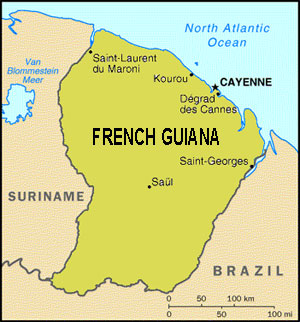 Map modified from a CIA graphic.
|
As a department of France, French Guiana has the largest tropical rainforest under the jurisdiction and the responsibility of a European country. One might think that with this status, and Europe's concern with global warming, biodiversity preservation, and the environment, French Guiana's forests would be treasured and safeguarded. This is not the case. Over the past decade illegal mining has affected extensive areas especially in the region bordering Brazil and Suriname where wildcat miners known as garimpeiros are wreaking havoc as they search for gold. To date the French government has taken a lackadaisical approach to addressing deforestation and illegal land invasions.
While official figures show only minimal deforestation in French Guiana, reports from border areas -- including nominally protected areas and the Nouragues tropical forest research station -- indicate a marked increase in illegal gold miners crossing in from Brazil. Surging gold prices and illegal mining crackdowns in Brazil are said to be driving the incursion of miners, whom local scientists report are polluting rivers and forests, depleting wildlife populations, cutting down forests, constructing clandestine roads, introducing disease -- especially malaria, and inciting violence. Government efforts to address mining are half-hearted and ineffective according to local scientists.
Mineral riches attract developers, large and small
French Guiana lies in a "greenstone" belt, a geological formation dating to around 2 billion years ago, that is particularly rich in gold deposits. The belt, which extends from Venezuela through Guyana, Suriname, Brazil, and French Guiana, has been a target of gold miners since the 19th century. The first gold rush in the region was in 1860, followed by another wave in 1910-1930. Since 1980s French Guiana's poorly monitored borders has made it an attractive mining site for more than 10,000 informal miners, called garimpeiros, from Brazil. These transient miners may presently amount to 5 percent of French Guiana's total population.
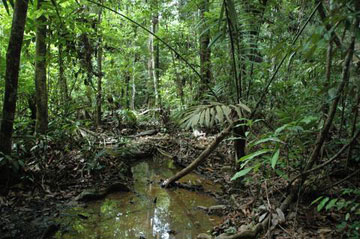 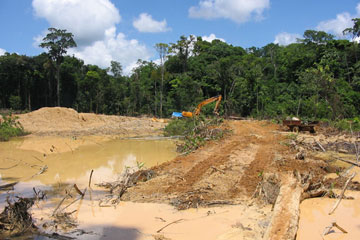 |
The garimpeiros rely heavily on hydraulic mining techniques, blasting away at river banks, clearing floodplain forests, and using heavy machinery to expose potential gold-yielding gravel deposits. Barge mining, a technique employing a large pipe to suck up river gravel and sand, is also widely used. Gold is usually extracted from this gravel using a sluice box to separate heavier sediment and mercury for amalgamating the precious metal. Informal miners ignore regulations requiring safe use and discharge of mercury, resulting in the toxic substance being redeposited in river water and the air as particulates. Mercury deposited in rivers can be methylated into organic forms where it then enters the food chain, accumulating in top level predators like otters, birds of prey, and humans. Samples taken in villages near mining areas in French Guiana found mercury levels six times higher than concentrations allowed by the European Authority. Studies in other parts of the world have linked mercury contamination to neurological disorders and birth defects in humans, especially infants. The only prevention -- warning locals not too eat too much fish -- is not practical in an area where most protein comes from fish and there are strong cultural ties among the indigenous population to fishing.
Beyond mercury contamination, the mining process generates other toxic compounds including oil and fuel waste and fine suspended particles that affect river navigation and fish populations by reducing the availability of oxygen. Mining further exposes previously buried metal sulfides to atmospheric oxygen causing their conversion to strong sulfuric acid and metal oxides, which run off into local waterways. Oxides tend to more soluble in water and contaminate local rivers with heavy metals.
Mining causes direct deforestation as well. According to French National Forestry Office (ONF) web site, as of 2006, 11,472 hectares of forest have been directly disturbed by legal and illegal mining activities. This represents a substantial increase from the 212 hectares that was disturbed in 1990, but the impact may be even greater than the raw numbers suggest says Dr. Pierre-Michel Forget, a biologist from the Muséum National d'Histoire Naturelle in Brunoy, France who has worked in the region for more than 20 years.
"Beyond the area directly cleared by mining, we need to consider collateral effects such as hunting and slash-and-burn agriculture that affect a much larger area," said Forget.
"Clandestine operations rely on bush meat," added Dr. Pierre Charles-Dominique, director of the Nouragues Natural Reserve research station of the Guiana Bureau of the National Scientific Research Center (CNRS). "Professional hunters operate on vast zones, preserve game in refrigerators and then sell it to the gold miners."
Charles-Dominique says studies conducted by the Kwata association, an environmental association partially funded by the French government, reveal declining game density in parts of French Guiana, including large drops in tapir and the peccary populations. He reports that miners take protected species including monkeys and macaws, and that in some areas miners are killing large number of fish employing a traditional fishing method used by Amerindians.
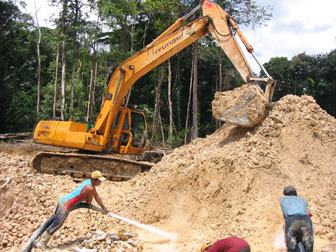 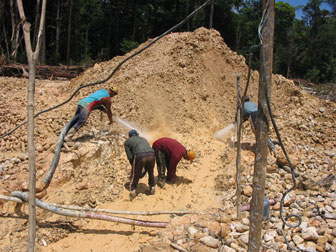 |
"The Amerindians use a technique that consists of temporarily poisoning sections of river using lianas containing rotenone, a compound that asphyxiates fish. Traditionally, this fishing technique is practiced in moderation and has relatively little impact on the fish fauna. However, on the upper Maroni where it is used in excess, the method impoverishes fish fauna, an important resource for the villagers, and reduces the availability of the lianas used for the practice."
Clandestine miners further damage the riparian environment by tearing up biologically sensitive areas including alluvial zones and small creek beds, key habitats for aquatic life. In the forest, they clear understory vegetation, while leaving some canopy trees to prevent patrol helicopters from landing. Charles-Dominique says these sites are difficult to locate with plane or helicopter, suggesting that mining damage may be underestimated.
Understory clearing can dry the forest, affecting species distribution and putting it at greater risk to forest fires. In abandoned mining areas, cleared forest can take more than 100 years to regrow. In the meantime, the vegetation shift changes the entire ecology of the ecosystem, transitioning from closed tropical rainforest to a weedy, less biodiverse landscape.
Beyond the environmental effects, mining has also been linked to the spread of malaria. The garimpeiros, who originate in the poor areas of northeastern Brazil, often carry the malaria parasite to regions where it was previously rare, while mining itself creates conditions ideal for mosquito breeding and malaria propagation. Additionally, the misuse of antimalarial drugs by the miners creates drug-resistant strains of the disease which is showing a resurgence in Guyana, with more than 12,000 reported cases between 2000 and 2002. The influx of prostitutes into mining camps has increased the incidence of AIDS and other sexually-transmitted diseases as well.
Miners themselves are at risk. Recruited from shantytowns and poor rural areas, some garimpeiros work under conditions analogous to slavery, falling deeply into debt with their bosses, who are usually based in Brazil, Suriname or French Guiana (Maripasoula or Cayenne). Further, their work is dangerous between inhalation of mercury fumes from the amalgamation process and having to dig in unsupported mining tunnels that are prone to collapse. Reports indicate that dozens of miners have been killed in mining accidents and violent conflicts over the past two yeas alone.
As situation deteriorates, France sends in the national police
In recent months incursions have reportedly worsened with thousands of illegal miners entering French Guiana. Garimpeiros have robbed ecotourist facilities, threatened researchers and locals, and even killed two nature guides. Local indigenous groups have mobilized but found little official support. While the French government has sent in more gendarmerie, as the French police are known, these efforts are widely viewed as ineffective since the gendarmerie are poorly equipped and poorly trained for forest vigilance activities.
The gendarmerie do not face an easy task. Trained as metropolitan police in urban settings, the gendarmerie are up against armed garimpeiros who know the forest well and are tipped off by sentinels who use mobile communications. In a place where the contract killing can be had for 100 euros and private militias are not uncommon, risks facing the gendarmerie are great - some have already been injured in confrontations.
"The gendarmerie makes regular patrols, but their movements are known in advance by the "frontier runners" which communicate by radio or portable telephone. Only 24 hour-a-day surveillance would be effective, but authorities are opposed to such measures," said Charles-Dominique.
"Only the army (foreign Legion) has the capacity to be driven in tropical forest... the soldiers would be far more effective than of the gendarmes who arrive from Europe and do not have any idea of this forest. But the French state refuses to utilize the army, even information sharing and logistical assistance, since it's not a war situation."
Charles-Dominique says that the inadequacy of the gendarmerie makes French Guiana an attractive target for the garimpeiros.
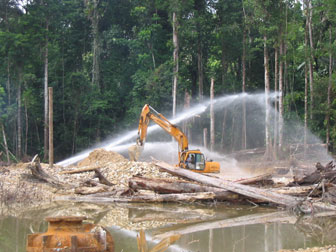 |
"While the gold bearing potentials of Suriname and Amapa, the adjacent Brazilian state, are equivalent to those of [French Guiana] ... the law there is such as that their respective forces have more legal power than French Gendarmerie. Further, their soldiers are well-experienced in the forest... whereas the majority of French, metropolitan gendarmes arrive to Guyana without ever have setting foot in the forest. It is partly why the garimpeiros choose to come to French Guiana. The worst which can happen to them deportation at the border, after which they can simply cross back into French Guiana. This is why clandestine gold mining is a much bigger problem than in neighboring Suriname and Brazil."
"When the gendarmes arrive in mining by helicopter all they can really do is tell the garimpeiros is leave -- there is no room for garimpeiros in the helicopter," said Philippe Menard of Les Verts de Guyane, an environmental group in French Guiana. "As such few garimpeiros actually leave mining areas."
For its part the French government has admitted to difficulties in the region, but beyond this recognition it seems to have shrunk from the problem, conceding that it cannot eradicate illegal mining from French Guiana. Instead the modestly aims for a "reduction" in mining activity according to Charles-Dominique.
Corporate interests move in
While the garimpeiros continue to cause problems, French Guiana's gold is also attracting corporate interests. Last week Auplata, a French mining company, said it was seeking funds to expand gold production in French Guiana. While environmental generally speak about the entrance of large mining firms in grave terms, research has found that, in practice, their relatively well monitored and regulated mining activities are less damaging than informal mining activities.
|
French Guiana Rainforest Figures Forest Cover
Total forest area: 8,063,000 ha
% of land area: 91.8%
Primary forest cover: 7,701,000 ha
% of land area: 87.7%
% total forest area: 95.5%
Deforestation Rates, 2000-2005
Total forest loss since 1990: -28,000 ha
Total forest loss since 1990: -0.3%
Primary or "Old-growth" forests
Annual loss of primary forests: -12000 ha
Annual deforestation rate: -0.2%
Primary forest loss since 1990: -60,000 ha
Primary forest loss since 1990: -2.6%
Forest Area Breakdown
Total area: 8,063,000 ha
Primary: 7,701,000 ha
Modified natural: 361,000 ha
Semi-natural: n/a
Production plantation: 1,000 ha
Production plantation: n/a
Plantations
Plantations, 2005: 1,000 ha
% of total forest cover: n.s.%
Annual change rate (00-05): n/a
Value of forest products, 2005
Industrial roundwood: $2,716,000
Wood fuel: n/a
Non-wood forest products (NWFPs): $4,099,000
Total Value: $6,815,000
|
"Compared to small-scale mining," said Forget, "companies such as Cambior (or Suralco and Rosebel in Suriname) are doing a far better job at protecting the environment. For example they take steps to prevent hunting in and around mining areas -- there are still spider monkeys in the forest near the Rosebel mine. They also offer decent life and salary for workers, seek to minimize their overall impact when building roads, and plan to rehabilitate the damaged destroyed habitats."
"Though the impact of their activities remain colossal, it is concentrated at one location and not diluted across the entire rainforest of the Guianas like that of the garimpeiros. This is the price to pay for development in countries such as Suriname and Guyana, if developed countries don't pay them for maintaining the forest cover. French Guiana and France shouldn't need to pay that cost -- France should be capable of underwriting forest protection," continued Forget. "We still must be diligent in making sure that large companies respect environmental regulations so as to avoid the damages we've seen at Omai, Guyana, and to oblige them to respect human right code as seen at Rosebel, Suriname. Though they are driven by profit, environmental concerns is something these firms appear to be taking seriously thanks to new laws»
"The companies responsible for these large projects express a will to respect the laws and limit the environmental impact of their activities. They are, in any event, easier to monitor and control than the cloud of small miners currently disseminated in the forest," added Charles-Dominique.
Forget says that while these large-scale miners typically create an open pit that requires clearance of several kilometers of forest they make efforts to capture pollution and follow mining laws the require restoration of damaged forest areas. He says that better collaboration between scientists and large-scale miners could pay dividends both in reducing the environmental impact of mining and making better use of the land once the mine operator have left. Forget suggests that ecotourism operations could blossom on former mine sites.
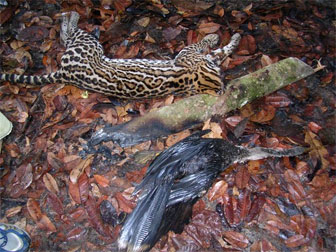 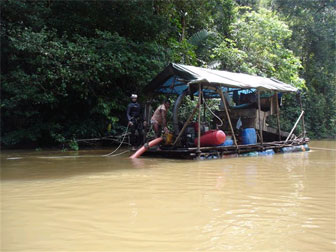 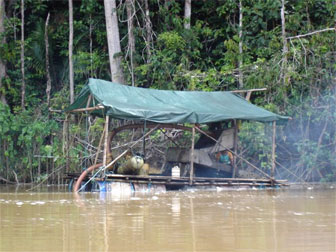 Forest animals fallen victim to hunters (top). Barge mining (middle and bottom).
|
"I believe that scientists must collaborate with large-scale forest developers, especially in developing countries where the environment can be another long-term source of income through tourism. For instance, the abandoned Rosebel mining area could be a very nice resort, a starting point to visit the forest and animals, especially given since the area is currently protected. Ten years from now visitors will be able to easily see wild animals in areas that were once mined. Once 'yellow gold' is exhausted, there remains 'green gold' in the form of forest which can be sustainably used over the long term to generate income long after the mine has been closed."
"While there are some areas of extremely high biodiversity or sensitivity that should definitely be off-limits to any form of mining or development like Kaw Mountain and the planned national park area, there are other areas in French Guiana where the forest can be mined in a responsible manner with fewer ecological concerns."
One idea put for by an association of gold miners in eastern Guyana was to establish legal rights to land. Requiring licensing could help displace clandestine miners who have no incentive to minimize damage to land. Supporters argue that it could slow the destructive mining, and that even though some groups don't follow most basic principles of mining code, licensing would at least establish some form of regulation.
Forget sees three additional steps to bringing order to the mining industry in French Guiana and reducing its impact on forests and biodiversity.
"First we need closer collaboration between Brazil and France on this issue, especially to stop emigration of homeless people from Brazil to the Guianas. These are the people who exploit forests. Second, the French government needs to establish permanent guard posts along rivers at some key portage points (like waterfalls) that are an obligatory stop when moving upstream. Third we need to know who in French Guiana is funding these illegal activities and hiring these Brazilian miners. None of this could be accomplished without some sort of local, financial and practical help and support."
Forget says that it is critical steps be taken soon to address the situation.
"Something has to be done quickly -- I'm not sure how much longer we can keep the area safe for research and ecotourism. We've already seen ecotourist guides killed and researchers threatened," he said. "French Guiana's forests are too important to be ignored by the authorities."
french guyana • land • www.agp.org (archives) • www.all4all.org